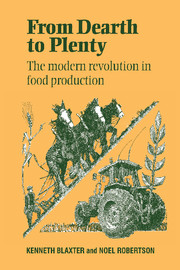Book contents
- Frontmatter
- Contents
- Preface
- Acknowledgements
- PART ONE The social, economic and political context of agricultural change
- PART TWO The science and technology of the modern agricultural revolution
- 3 Problems of measurement
- 4 Mechanisation
- 5 Soils, fertilisers and water
- 6 The control of weeds, pests and plant diseases
- 7 Breeding more productive plants
- 8 Integrations and innovations in crop husbandry
- 9 Hunger in the midst of plenty
- 10 Better and more productive animals
- 11 Animal health and disease
- 12 Integrations in animal husbandry
- PART THREE How did the science-based revolution happen, and what is the way forward as support is withdrawn?
- Glossary
- Index
8 - Integrations and innovations in crop husbandry
Published online by Cambridge University Press: 04 August 2010
- Frontmatter
- Contents
- Preface
- Acknowledgements
- PART ONE The social, economic and political context of agricultural change
- PART TWO The science and technology of the modern agricultural revolution
- 3 Problems of measurement
- 4 Mechanisation
- 5 Soils, fertilisers and water
- 6 The control of weeds, pests and plant diseases
- 7 Breeding more productive plants
- 8 Integrations and innovations in crop husbandry
- 9 Hunger in the midst of plenty
- 10 Better and more productive animals
- 11 Animal health and disease
- 12 Integrations in animal husbandry
- PART THREE How did the science-based revolution happen, and what is the way forward as support is withdrawn?
- Glossary
- Index
Summary
So closely integrated are the various elements in the management of a farm that deviation from the established pattern of husbandry has always been exceptional and not undertaken lightly. Every so often periods of innovative risk-taking have emerged to break through the barriers of conservatism, as in the agricultural revolution of 1700–1860 (see Chapter 1). Another such period we have identified in the modern agricultural revolution (1936-86). In the 1920s, a time of severe agricultural depression, any innovation was driven by desperation. An example was the Hosier Bail, a light movable shed for machine-milking cattle out of doors, saving on the cost of housing, cleaning floors and buildings.
As already indicated, the Second World War and the passing of the Agriculture Act of 1947 (and its later modifications) improved the agricultural situation in the U.K. In the war years maximisation of production had been required to feed the population. The Act of 1947 put in place managed and supported markets designed to encourage sustained production, buffered against the fluctuations of world surpluses. It provided a reasonable income for farmers, tolerable wages for their staff and sufficient profit for the ancillary industries dependent on agriculture. These fiscal measures encouraged innovation because incomes from year to year were predictable and reasonably secure. At the same time incomes were tightly controlled overall and closely associated with traditional cropping and animal production patterns. Thus any innovation that allowed intensification, or which provided a non-traditional product, offered the possibility of increased income.
- Type
- Chapter
- Information
- From Dearth to PlentyThe Modern Revolution in Food Production, pp. 144 - 165Publisher: Cambridge University PressPrint publication year: 1995

